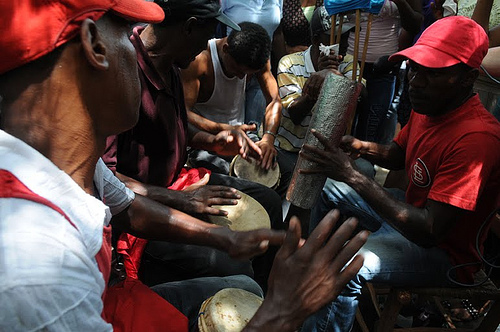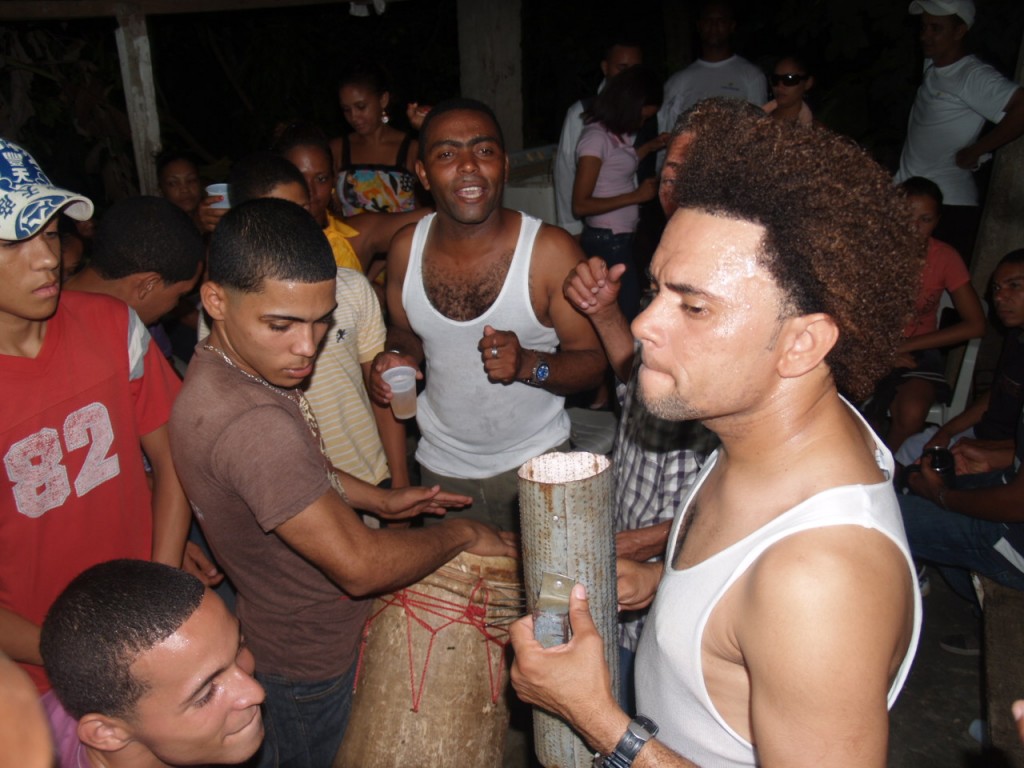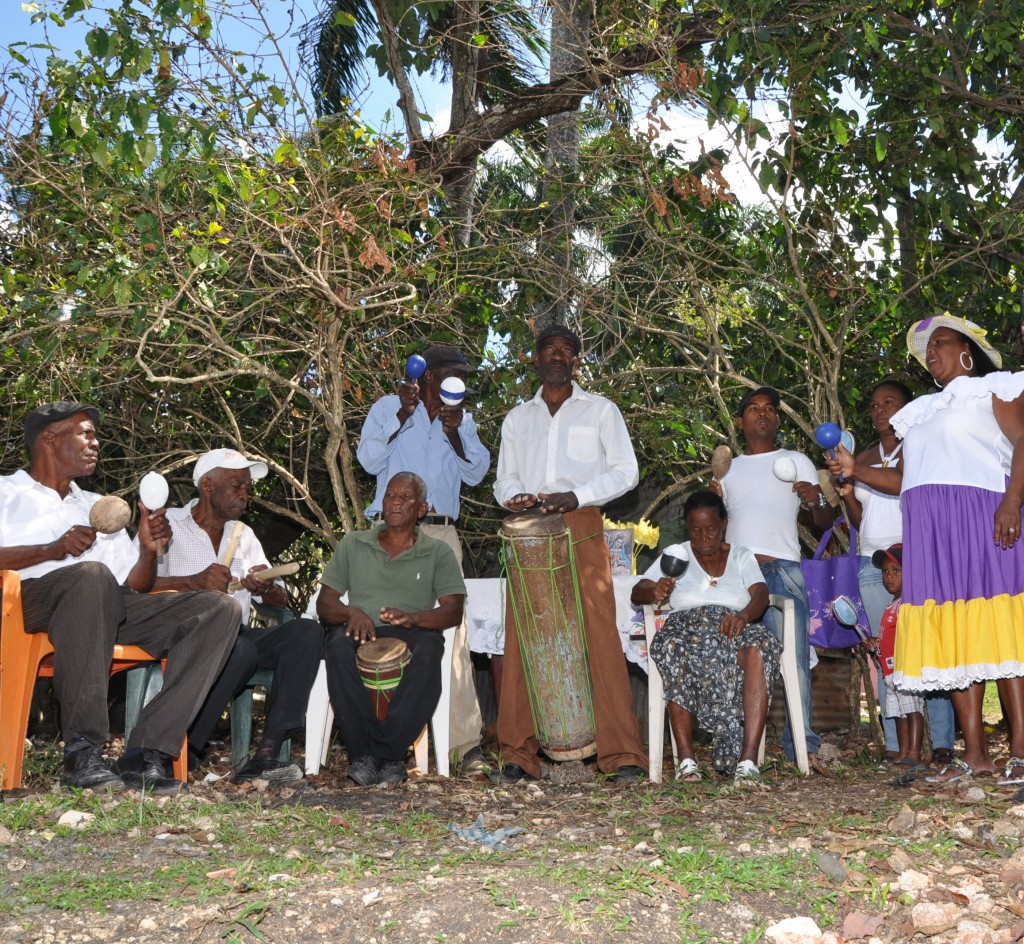We bring some much needed-attention to Afro-Dominican music, some of the richest and least-known sounds coming from the Caribbean. The Dominican Republic is best known for merengue and bachata, two essential parts of the mainstream Latin music landscape. Both styles have heavy African influences, but aren’t considered “Afro-Dominican” music – that term is reserved for the 60 some-odd traditional rhythms found on the island, deeply-African sounds that make the complex grooves of salsa or merengue look like beginner’s stuff. There is an astounding musical diversity. Whole music traditions can change from one town to the next, each with its own choir of unique instruments.
Although there are secular styles as well, most Afro-Dominican music is deeply integrated with Afro-Dominican religion, syncretic practices that fuse the Catholic saints to African deities, much like Cuban santeria or Haitian vodou. From energetic Saint’s Day parties to private ceremonies to mass pilgrimages, Afro-syncretic spiritual activities play a major part in the lives of many Dominicans, and music is always there at the center, providing an ecstatic, transcendent, communal way of interacting with the divine.
Afro Dominican music is a well-kept secret thanks to a long and complicated relationship between Dominicans and their strong African heritage, further nuanced by the 31-year dictatorship of Rafael Trujillo, who actively persecuted the country’s African cultural manifestations in an obsessive quest to Europeanize the country. Even though Afro-Dominican music is played every day, it is rarely discussed in public – it’s almost a taboo.
Nevertheless, the traditions are strong – this is living, breathing folklore. Whereas in some countries, traditional music is dead except for nostalgic recreations by folkloric ensembles, this music is thriving with virtually no support of any kind.
Below, you’ll find a brief guide to Afro-Dominican music styles – by no means a complete list. Take a second to follow the links and see the traditions being practiced for yourself. Also, don’t forget to scroll to the bottom for links and information on the Afro-Dominican fusion artists featured on our radio program.
Salve
Palos and salve are the most common styles of Afro-Dominican music. In fact, some ethnomusicologists say that palos should be the true Dominican national music, rather than merengue, since it’s found in some form virtually everywhere on the island. Palos, which means “sticks”, gets it’s name from the trio of tall, skinny drums it is played on. The drummers are accompanied by the omnipresent Dominican guira or metal scraper, and singers who venerate the Catholic saints and their sycretized African counterparts with call-and-response style melodies and improvised verses.
The music is an essential part of Afro-Dominican spiritual life. Popular religious celebrations are often referred to as fiesta de palo, or palos party, after the dominant role of the drum. Ceremonies usually occur on the Saint’s Days of the Catholic devotional calendar. For example, October 20th is Santa Marta’s day, so her devotees might arrange an party in her honor. In towns or neighborhoods where she is the patron saint, there will likely be a novena, in which festivities occur for nine straight nights, culminating in a all-night party on the actual Saint’s Day. In either case, an altar will be made and palos drummers will play, often for hours and hours on end. As the music intensifies, worshipers may undergo possession, in which the deity descends to the Earth to give advice, relay messages from deceased relatives, or sometimes just to have fun. Once the possession stops, the person often has little or no recollection of what just happened.

Image from LAMECA archive
These may be religious events, but they aren’t staid affairs in any sense – people drink, dance, sing, and have a good time, and its all about bringing the community together. While most palo songs are about the virtues and exploits of the saints and gods, many are just festive songs with secular topics.
http://youtu.be/j1a7XNcm1Jg
Salve may be played in fewer parts of the country but it’s one of the best-known sounds, largely because it’s the sound of choice in Villa Mella, a poor suburb of the capital often thought of as the epicenter of Afro-Dominican traditions. The salve group of Enerolisa Nuñez, from Villa Mella, is one of the most widely listened to - thanks to her inclusion in merengue-star Kinito Mendez’s salve-merengue fusion album A Palo Limpio as well as an excellent recording of her group by the Bayahonda Cultural Foundation.
http://youtu.be/EI1r42djcUA
Congos
Congos is a unique musical phenomenon that has intrigued anthropologists both at home and abroad for decades. It’s played by a group called the Cofradia de Los Congos del Espiritu Santo de Villa Mella, a religious brotherhood based in Villa Mella and the guardians of a musical tradition that dates back several centuries. The cofradia is thought to be directly descended from the religious-fraternal organizations of enslaved Africans during the Colonial Period. Africans from similar cultural regions on the continent often bonded together in these societies, and the music of the Congos is thought to be rooted in styles from Central Africa.
The group is organized into a hierarchy, with a king, a captain and other titles, and membership is passed down the generations. Their responsibility is to maintain and pass on a cannon of 21 songs, played on a unique set of self-made shakers, claves and drums. The music is most often played for the funeral rites of Cofradia members, helping the passage of their souls to the next world. After death, congos music is played for a nine-night novena, and the ceremony is repeated a year later and then again two years after that. The ritual displays a strong linkage to African ways of dealing with life and death.
The congos were recognized by UNESCO in 2001, raising the group’s national profile in a country hesitant to support Afro-Dominican culture. When long-standing Congos leader Captain Sixto Minier passed away in 2008, there was an impressive outpouring of affection. Still, the government has been criticized for not doing enough to support the group, and the congos continue to struggle in the difficult material conditions they’ve faced for centuries.
http://youtu.be/xaxCnHCAw2Y
Gagá
One of the most popular sounds for Afro-Dominican revivalists, is the music of the bateyes, the sugar-cane cutting camps where Haitians and Dominicans live and work side-by-side. is rooted in Haitian, a kind of street music played in parades during the Lenten season. It’s music for the forest spirits – for the renewal and rebirth found in nature, echoing Christian Easter themes of resurrection. The breakneck-paced music is played on drums and percussion, but also with a series of one-note homemade trumpets made out of wood and metal. The trumpets interlock to create haunting melodies in an effect known called hocketting.
Haitians suffer heavy discrimination in the Dominican Republic, thanks to a long history of anti-Haitian indoctrination from Dominican elites. Many Haitians illegally reside in the much more prosperous D.R. and are frequent victims of abuse by employers and police. Haiti is a major factor in the racial complexities of Dominican society. After rebelling against the French and declaring independence in 1804, Haiti conquered the Spanish half of the island. Dominicans won their independence from Haiti, not Spain, and have long constructed their identities in opposition to an African, Haitian “other.”
- Picture by Justin Mercer














